
History of Elston
Location
The parish of Elston lies between the rivers Trent and Devon, with the village itself set amongst trees and farmland less than a mile from the A46. The historic market town of Newark is just five miles to the north, with the cities of Lincoln and Nottingham some eighteen miles north and southwest respectively.
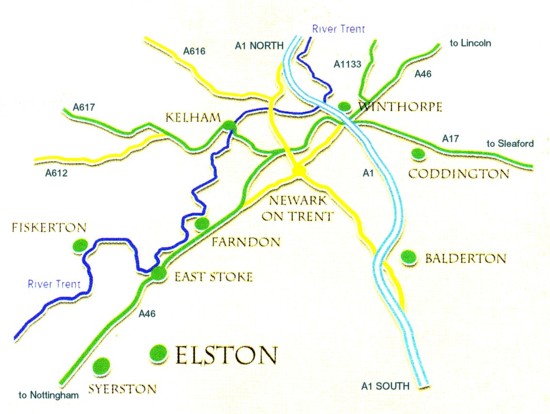
The parish is broadly wedge shaped, 5.7kms long and 540m wide at its narrowest western point along the Trent and widening to 1.84kms at Cross Lane close to its eastern extremity at the River Devon. The area between the Trent and the A46 is 1.4kms long, bordering Syerston Airfield and Syerston Hall on the southwest and the Stoke battlefield on the northeast and widening to 900m where it abuts the A46. The greater part of the parish lies to the east of the A46 bordering East Stoke to the north, along the line of the Codder’s Dyke for much of the way, and on the south borders Syerston and Sibthorpe parishes.
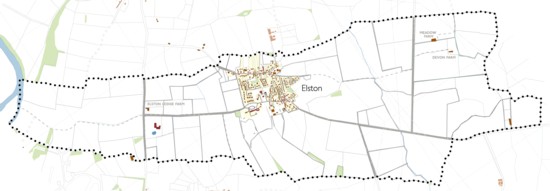
Prehistoric Elston
It is perhaps appropriate to begin by disposing of the oft told story that the earliest known inhabitant of Elston was an ichthyosaur whose fossilised skeleton was found in the grounds of the first rectory. A rectangular flagstone, which contained parts of the skeleton of a plesiosaur, had been used for many years for containers to stand on near the well, the precise position of which is unknown. The stone was quarried at Fulbeck on the escarpment that runs the length of Lincolnshire and which contains a wealth of fossil marine and shell remains. It was probably brought here by John South, Elston Rector from 1702 to 1732, who had previously been Rector at Fulbeck since 1694 and had an interest in curiosites. Robert Darwin saw the fossil in 1718 and told his friend John Stukely, who then took credit for the 'discovery.'
The oldest archaeological find is a Stone Age flint blade found by Michael Sparkes, a pupil at the village school, in a field off Carrgate Lane near the bridge over the Carr Dyke. The blade is about ten thousand years old. Michael had a large collection of Romano-British pottery fragments from the area, many of them from the same field. Crop markings showing two concentric rings of post holes half a mile east northeast of Elston on Stoke Fields Farm and a little outside the parish, suggest the site of a henge monument or an Iron Age building but no surface features are visible.
Historic Elston
Elston has witnessed a number of important historical events over the centuries and we have much to commemorate. The whole area is steeped in history and great events have taken place around Elston. The Romans built a settlement at Margidunum (Bingham) and at the river crossing at Ad Pontem (East Stoke) on the Fosse Way (A46) that joined Isca (Exeter) to Lindum (Lincoln). At least two Roman farmsteads or small villas stood within the parish, one on the Trent Hills across the Fosse Way and the other on Brecks Lane towards the River Devon. Isolated Roman coins have also been found near Appleacre on Low Street and near Sharah House in Elston Lane.
The Danes sailed up the Trent and settled at neighbouring Thorpe and Gunthorpe. Elston itself was founded by the Angles in the 5th century, and its square shape is typically Anglo-Saxon. In 1487, Henry VII put down Lambert Simnel’s rebellion at East Stoke, in the final battle of the War of the Roses. While the English Civil War raged, Royalist Newark was besieged by the Parliamentarians. And Elston was the birthplace and home of the savant Erasmus Darwin, friend of Robert Boyle and Benjamin Franklin, and grandfather of the more famous Charles. During the Second World War, nearby Syerston airfield was used for training RAF bomber crews and as a base for Wellington and Lancaster bombers.
Origin of the name
The Domesday Book of 1086 is the first record that mentions the village by name, where it is called Elvestone, but soon afterwards there are other spellings, including Eyieston, Ayleston, and Ailaston. From these early variants the name seems to be a hybrid of the name of a Scandinavian or Danish owner named Eilaf and the Anglo Saxon tun, which originally meant a fence, but which then very soon was applied to any village surrounded by a fence. There must have been an Anglo Saxon name for the village but, probably soon after 877 AD when the Danish Army took over many of the villages in the Midlands, a Danish owner became the local Lord and it took the name of the new owner but kept the older Anglo Saxon ending tun, presumably because most of the inhabitants were Anglo Saxons and not Danes. In time the name Eilaf’s tun eventually became Elston.
Nothing visible remains of this period except the lower stonework of the church tower, which is thought to be Saxon in origin. Although there is a record that the Black Death visited Sibthorpe and probably carried off a third of the inhabitants there is no corresponding record of how it affected Elston, though the situation was likely to have been much the same. A poor quality ring dating from the late 15th century was found by Nicky Renyard in the family’s garden at ‘Sunnyside’ Mill Road in the early 1960s and may therefore be associated with the battle at Stoke in 1487.
Civil Wars
Stoke Field, the last battle of the War of the Roses, effectively secured the throne for Henry VII by the defeat of the Earl of Lincoln and Lambert Simnel on June 16th 1487. It was fought at East Stoke but was probably close enough to Elston for at least some of the forces to have been engaged in the fields around the village. An ancient spring rises in a field on the south side of Elston Lane and runs through a culvert to a stone trough at the side of the road. It is known as the Willow Rundle and is reputedly where a soldier, mortally wounded in the battle, took his last drink.
During the Civil War of the 1640s both the Lascelles and the Bristowes appeared to be on the Parliamentary side but do not seem to have taken up arms. However, Elston was too close to the Royalist Garrison at Newark, and to that of Parliament at Nottingham, to escape. In May 1644 two hundred weary Royalist troops were quartered in Elston and were successfully surprised at night by Col. Hutchinson’s troops from Nottingham, resulting in the capture of thirty or forty prisoners, together with their horses and arms. Besides this clash in the streets of Elston the villagers must have suffered from both garrisons because their horses, cattle, sheep, pigs, chickens, hay and other produce were requisitioned, often without payment. They must have been very relieved when the fighting ended in May 1646.
A veteran of the American Civil War, Thomas Hagues, lived at Nashville in Low Street. He was born at Little Carlton near Newark in 1842 and emigrated to America in 1860. He fought on the Union side and returned to his native village at the end of the War in 1865. By 1914 he was living in Elston and was interviewed by the Newark Advertiser for his views on fighting large-scale wars and the part he played in the American Civil War. He died in 1924 and was buried next to his wife in Sheffield.
Layout of the village
The village consists of four streets in a rectangle - Top Street to the south of the church, and Low Street (formerly Bottom Street) to the north, joined by Pinfold Lane on the west and Toad Lane on the east. This area had been divided up into small closes or crofts around a large green for hundreds of years, but until 1801 the rest of the parish was in open arable fields, meadows and commons ( North Field, South Field, East Field and West Field). Mill Road (formerly Kilvington Street before the mill was built) begins at the junction of Toad Lane and Top Street and becomes Brecks Lane just outside the village, leading to Shelton, Sibthorpe and Long Bennington. Lodge Lane begins at the junction of Pinfold Lane with Top Street and leads to the Fosse Way (A46). Elston Lane (formerly Stoke Road) begins at the junction of Pinfold Lane and Low Street and joins the Fosse Way close to East Stoke. Old Chapel Lane used to be called Doncaster’s Lane after the family that owned the bakery there. Two footpaths connect Low Street with Top Street and are known locally as ‘Big Scutchel’ and ‘Little Scutchel’. The word “scutchel” originally meant a fork or a branching, but in this context it is thought to mean ‘short cut’.
ANOTHER MAP TO GO IN HERE SHOWING THE STREETS OF THE VILLAGE
Pinfold Lane takes its name from ‘penfold’ or ‘pinfold’, an enclosure for keeping stray cattle or horses until their owners could collect them. The wooden gate and a high hawthorn hedge in front of No 13 are the only remains of the former enclosure. The owner paid a fine to the pinder for rounding the animals up and keeping them till they were claimed. The last pinder, William Dixon, lived at ‘Hollydene’ in Elston Lane and died in 1920, aged 88 years.
The oldest buildings
The remains of a Roman villa were found to the right of Brecks Lane towards the turning to Sibthorpe. Historic old buildings still standing in, and adjacent to, the parish include Elston Hall, All Saints Church, Elston Chapel on the site of a mediaeval leper hospital, the Methodist Chapel, and Elston Towers, the Victorian mansion of lay preacher Robert Middleton, now refurbished as a day spa and renamed Eden Hall. Some of the old houses are completely, or partly, built of stone but most are of red brick, probably from the local clay. One brick pit was at the back of Toad Lane in what is now the garden of Sunnyside and another was in what is now the garden of Dellary in Mill Road.
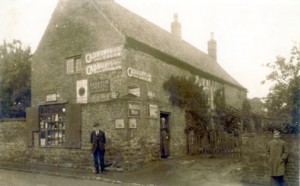 The oldest properties in the village are in Low Street. Possibly one of the earliest dwellings in the village, dating back to the 16th century or even earlier, is shown in the 1851 census as a bootmakers, but which by 1881 had become a grocers and post office. The proprietor, Richard Beeston (shown here in front of the shop) died in 1895, but his daughter Emily Jane carried on the business. She never married, but in the early 1900s her cousin, Thomas Beeston, came to live with her. Thomas had a small shoemakers’ shop next door to the Chequers Inn at Elston in 1871. His wife, Esther was a milliner and dressmaker. The family was living in Newark at 38 Castle Gate in 1876. He was a leather cutter and later became a seed merchant. In 1928 the post office was transferred to Appleacre in Low Street when Miss Beeston retired after being postmistress for 50 years. The following year Thomas died. The property became known as Smith’s Shop from 1939, when it passed into the tenancy of the Smith family on the death of Emily Ann Beeston. The Smiths lived there until 1993 when the shop was sold by the owners, St. Leonard’s Hospital Charity of Newark. They had owned the property from at least the mid 19th century. It has been sympathetically restored and is now Ardmore House.
The oldest properties in the village are in Low Street. Possibly one of the earliest dwellings in the village, dating back to the 16th century or even earlier, is shown in the 1851 census as a bootmakers, but which by 1881 had become a grocers and post office. The proprietor, Richard Beeston (shown here in front of the shop) died in 1895, but his daughter Emily Jane carried on the business. She never married, but in the early 1900s her cousin, Thomas Beeston, came to live with her. Thomas had a small shoemakers’ shop next door to the Chequers Inn at Elston in 1871. His wife, Esther was a milliner and dressmaker. The family was living in Newark at 38 Castle Gate in 1876. He was a leather cutter and later became a seed merchant. In 1928 the post office was transferred to Appleacre in Low Street when Miss Beeston retired after being postmistress for 50 years. The following year Thomas died. The property became known as Smith’s Shop from 1939, when it passed into the tenancy of the Smith family on the death of Emily Ann Beeston. The Smiths lived there until 1993 when the shop was sold by the owners, St. Leonard’s Hospital Charity of Newark. They had owned the property from at least the mid 19th century. It has been sympathetically restored and is now Ardmore House.
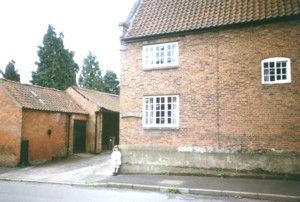
Across the road is Manor Farm, where Elston’s Manorial Courts were held from the early 1600s until the enclosure of the village in 1801. The eastern end dates back to at least the 16th century, the west end being destroyed by fire and demolished in the early years of the 17th century. In the garden of the last house in the Spinney, which abuts Manor Farm and the Big Scutchell, are the remains of medieval fishponds. These ponds would have originally belonged to Manor Farm until 1968 when the owner sold the land for development. Tudor Farm (see picture) dates from 1710 and parts of Poplar Farm are also very old. Many of the cottages in Low Street were built in the 18th century, and some have date stones built into their gables. Elm Cottage has “FF 1724”, probably signifying Francis Farr, who married in 1716. Berkeley Cottage has “RBH 1720”, the initials of Richard Barrow and his wife, Hannah, married in 1719. Ivy House has “TDS 1729” for Thomas and Sarah Derry, the first occupants. The central chimneystack of the row of four cottages called Baileys, Cob, Willow, and Rhizome Cottages bears the date 1839. Cobbler’s Cottage and Kirklevington on the corner of Top Street and Mill Road were built in 1799. Rose Cottage in Mill Road has a plaque showing that it was built in 1815. Oakwood Cottage next to The Chequers in Toad Lane was also a shop until the end of the Second World War, as was May Cottage. And more recently in Top Street, the Old Post Office was a general store and post office until 1999. The interior of the blacksmith’s forge in Low Street, now The Forge, remains intact despite alterations in 2007, but the bakery in Old Chapel Lane (formerly Doncaster’s Bakery) was pulled down in 1973 and a house, Meadow View, now stands on the site. There was also a fish and chip shop in Low Street in a wooden building at the bottom of the Big Scutchel until about 1960 where The Limes now stands. The family that ran the shop were named, somewhat appropriately, Codd.
Trades
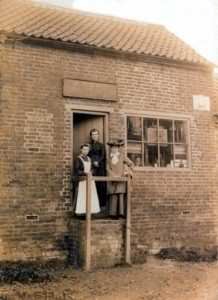
There is now only one shop in the village, opened in 2005. In the last century it was far different. In 1853, like most villages of its size, Elston had six shoemakers, four joiners, two blacksmiths, two bakers, two butchers, two tailors, two corn millers, two wheelwrights, a saddler (see picture), a brick and tile maker, a bricklayer, and a basket maker. The last craftsman basket maker, using reeds from Elston’s own rush ponds near the Little Scutchel and by Mill Road, was John Rawson, who died in 1959. Latterly he lived at Rose Cottage, later called Sharah House in Elston Lane.
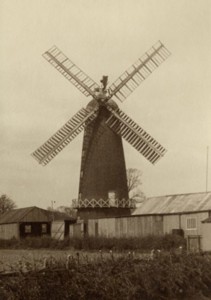 There were at one time two windmills in the village. One was on the south side of Elston Lane and has long since disappeared. The one in Mill Road was built in 1845 by John Lee on land he had purchased in 1844 from Richard Greasley, the licensee of the King William IV beerhouse. The mill was quite a landmark, and was known locally as “The Black Giant”. It remained in the Lee family until shortly after the death of John Lee in 1901, before passing to the Darwins, who sold it to William Gash in 1919. Until 1930 Gash used to produce cattle feed here and at another mill in Long Bennington. He also founded a bus company, which was first based at the Elston Mill but later moved to Newark. The mill was working until 1940 when the sails were removed as they were considered to present a marker to German aircraft attacking nearby Syerston airfield. It was converted to a dwelling house in 1978.
There were at one time two windmills in the village. One was on the south side of Elston Lane and has long since disappeared. The one in Mill Road was built in 1845 by John Lee on land he had purchased in 1844 from Richard Greasley, the licensee of the King William IV beerhouse. The mill was quite a landmark, and was known locally as “The Black Giant”. It remained in the Lee family until shortly after the death of John Lee in 1901, before passing to the Darwins, who sold it to William Gash in 1919. Until 1930 Gash used to produce cattle feed here and at another mill in Long Bennington. He also founded a bus company, which was first based at the Elston Mill but later moved to Newark. The mill was working until 1940 when the sails were removed as they were considered to present a marker to German aircraft attacking nearby Syerston airfield. It was converted to a dwelling house in 1978.
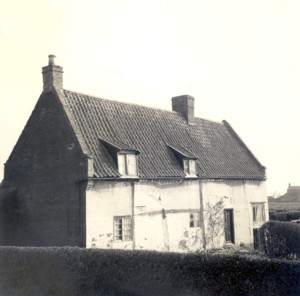
There were once three public houses in the village. The Chequers in Toad Lane is the only one still licensed. The King William IV closed in 1915 and is now a private residence called The Old Alehouse. A Tudor dovecote stood at the rear of this building and was converted to a dwelling in 2007. The Horse and Gears, on the corner of Pinfold Lane and Elston Lane, closed in 1936 through lack of trade and is now Corner Cottage. The Chequers was the only pub that held a full licence for beer, wine and spirits, as it was an inn. The King William IV and the Horse and Gears were classed as beer houses and licensed to sell only beer, and later wine. There was reputedly a beer house called ‘The Blue Bell’ in Mill Road, though there is no documentary evidence to support the claim. But a wattle and daub building, latterly called Tudor Cottage(see picture), which may have been The Blue Bell, stood across what is now the entrance to The Orchard and was occupied until the early 1960s, when it was condemned and demolished.
Church and Chapel
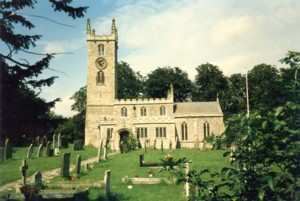 All Saints Church is in part a 13th century building on the site of a Saxon church and can boast a list of rectors from 1268. The original 13th century church had a tower, nave, south aisle and chancel. The tower was rebuilt in the 17th century. Further building and restoration was carried out in the 14th, 15th, and 17th centuries. The font is an unusually small one but must be medieval because of the marks of the staple and hinge of its original cover; so it probably dates from the 14th century. In 1479 John Methley, a lawyer who probably lived where Elston Hall now stands, left money for the aisle of John the Baptist (the south aisle) to be lengthened by nine feet, in order that he might be buried there. Robert Wright of Elston left money for the building of a vestry.
All Saints Church is in part a 13th century building on the site of a Saxon church and can boast a list of rectors from 1268. The original 13th century church had a tower, nave, south aisle and chancel. The tower was rebuilt in the 17th century. Further building and restoration was carried out in the 14th, 15th, and 17th centuries. The font is an unusually small one but must be medieval because of the marks of the staple and hinge of its original cover; so it probably dates from the 14th century. In 1479 John Methley, a lawyer who probably lived where Elston Hall now stands, left money for the aisle of John the Baptist (the south aisle) to be lengthened by nine feet, in order that he might be buried there. Robert Wright of Elston left money for the building of a vestry.
William Brown Darwin thoroughly repaired the church in 1837. Most of the window tracery was renewed, some of the outside stone replaced, and the crenellations above the south aisle and clerestory were added at this time. The top of the tower was rebuilt to make room for the clock and the massive pinnacles at the corners. The cost of these repairs was £2000 (£175,000 at 2006 values). The clock was made in 1838 by John Whitehurst of Derby to mark the coronation of Queen Victoria the previous year. Whitehurst was a friend of Erasmus Darwin and tendered (unsuccessfully) to build the clock for the Houses of Parliament in London (Big Ben). In 1859 further repair work was needed, which entailed the rebuilding of the north wall of the nave and chancel due to subsidence at a cost of £400, which was raised by public subscription. The vestry was moved and rebuilt at this time, and in 1872 the present organ was installed.
Extensive internal alterations were again carried out in 1912 by the Darwin family including rebuilding the chancel arch in stone, replacing the altar, altering the chancel to its present form, moving the font, and replacing pews that had originally been installed in 1837 with chairs. A sixth bell was also installed at this time and the five original bells were removed and retuned. The six bells were then re-hung in a new iron frame. Electric lights replaced the old oil lamps in 1932. The present wooden pews came from St. Leonard’s Church in Newark when it was demolished in 1974.
The original Elston rectory stood in the churchyard fronting Top Street. A new rectory, now known as The Old Rectory, was built in 1855 and in the early 1870s the first rectory was demolished, the site being consecrated as a graveyard in 1873. This served as the rectory till it was itself replaced by a modern house in 1979 on the site of the old coach house.
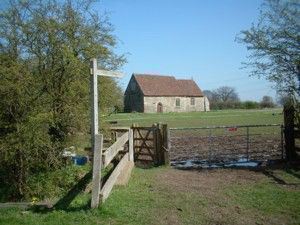 The other church in the Parish is Elston Chapel, these days known as The Old Chapel, which is situated in a field to the north and on the very edge of East Stoke parish. It is believed that it once formed part of, and is all that now remains of, the mediaeval leper Hospital of St Leonard’s, which was rebuilt in 1577. Until 1872, Elston had for centuries been administered as two separate parishes ; Church Parish covering the south of the village and Chapel Parish the north. The building was actually in the parish of East Stoke before the boundary changes of 1884, but was nevertheless always known as Elston Chapel.
The other church in the Parish is Elston Chapel, these days known as The Old Chapel, which is situated in a field to the north and on the very edge of East Stoke parish. It is believed that it once formed part of, and is all that now remains of, the mediaeval leper Hospital of St Leonard’s, which was rebuilt in 1577. Until 1872, Elston had for centuries been administered as two separate parishes ; Church Parish covering the south of the village and Chapel Parish the north. The building was actually in the parish of East Stoke before the boundary changes of 1884, but was nevertheless always known as Elston Chapel.
The chancel has the date 1577 over the outside of the East window and the same date is engraved inside the chancel. Another window in the chancel is 14th century and there are similar ones in the nave. Separate registers exist for the chapel from 1584 but, although burials were entered until 1729, they do not seem to have taken place in the chapel field, but mostly at East Stoke, except where Elston churchyard is mentioned.
The chapel still contains traces of 18th century texts on its inside walls and part of a 17th century royal arms. About 1820 it was re-fitted with box pews and at that time the walls were lined with hat pegs. In 1872 it became the responsibility of the rector of Elston after the Church and Chapel parishes were finally united ; prior to this date the vicar of East Stoke had given the services there. It remained in use until the end of the 19th century with one service a month. The last wedding was in 1873 and the final baptism in 1878. By about 1960 the chapel was becoming derelict and subject to vandalism but in 1977 the Churches Conservation Trust carried out emergency repairs, especially to the roof, utilising old pantiles from Manor Farm, which was being retiled at that time. In 1978 the building and the land within the surrounding railings was placed in the hands of the Trust, after which a programme of extensive repair work was undertaken.

The original Wesleyan Methodist Chapel, built in 1815, was near the corner of Pinfold Lane and Elston Lane and was comverted into a dwelling. It was later demolished, probably in the 1960s. Hollydene now stands close to the site. In 1839 an Independent Primitive Methodist Chapel was built in Low Street and is now a dwelling called The White House. The original chapel in Pinfold Lane was closed when the present Methodist Chapel was built in 1871 and its date stone of 1815 was placed in front of the new building. The Primitive Methodist Chapel also closed at this time.
Schools
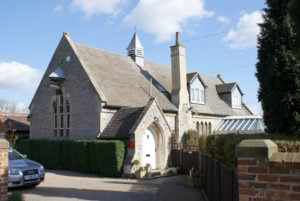 A Grammar School was endowed in Elston as early as 1614 by the will of a former rector, Laurence Pendleton, but was not actually founded on a secure footing until 1653 when land was purchased to provide an income for the schoolmaster. However, its teaching always seemed to be elementary. In 1784 Elizabeth Darwin left money to the school and Robert Waring Darwin rebuilt the schoolhouse in 1812. The schoolhouse and the master’s house were situated on the left of Elston Lane on the way to East Stoke, now Sharah House. What is now called The Old School House (shown here), situated at the Top Street end of the Big Scutchel, was built in 1856 and served as a primary school until the present All Saints Church of England and Methodist School was built on the Village Hall Field behind the Church in 1974. Elston Hall became a Roman Catholic School in 1955 until 1976 when it was sold to a developer and converted into separate dwellings.
A Grammar School was endowed in Elston as early as 1614 by the will of a former rector, Laurence Pendleton, but was not actually founded on a secure footing until 1653 when land was purchased to provide an income for the schoolmaster. However, its teaching always seemed to be elementary. In 1784 Elizabeth Darwin left money to the school and Robert Waring Darwin rebuilt the schoolhouse in 1812. The schoolhouse and the master’s house were situated on the left of Elston Lane on the way to East Stoke, now Sharah House. What is now called The Old School House (shown here), situated at the Top Street end of the Big Scutchel, was built in 1856 and served as a primary school until the present All Saints Church of England and Methodist School was built on the Village Hall Field behind the Church in 1974. Elston Hall became a Roman Catholic School in 1955 until 1976 when it was sold to a developer and converted into separate dwellings.
Elston Towers
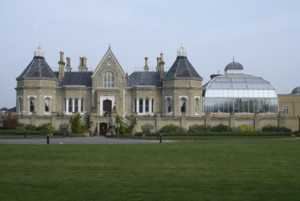 Middleton House or Elston Towers, situated where Lodge Lane joins the Fosse Way and now known as Eden Hall Spa, was built by Robert Middleton in 1872/5. Middleton was born near Thirsk in Yorkshire in 1814 and died at Elston on 2nd June 1885. The house was built from stone salvaged from the old Trent Bridge in Newark, and its furniture included tables from the Tuileries Palace originally used by Napoleon III. It was constructed in the Tudor/Gothic style at a cost of nearly £30,000 (£2.6 million at 2006 values) and contained a Baptist chapel in the centre, complete with organ and baptistery. There is a splendid terrace at the front, onto which all of the principal rooms had access. The conservatory at the south end once held 2.000 plants and was accidentally destroyed in 1942 when a Lancaster bomber exploded on Syerston airfield. It was rebuilt in 2005 and now serves as a lounge for day visitors between treatments.
Middleton House or Elston Towers, situated where Lodge Lane joins the Fosse Way and now known as Eden Hall Spa, was built by Robert Middleton in 1872/5. Middleton was born near Thirsk in Yorkshire in 1814 and died at Elston on 2nd June 1885. The house was built from stone salvaged from the old Trent Bridge in Newark, and its furniture included tables from the Tuileries Palace originally used by Napoleon III. It was constructed in the Tudor/Gothic style at a cost of nearly £30,000 (£2.6 million at 2006 values) and contained a Baptist chapel in the centre, complete with organ and baptistery. There is a splendid terrace at the front, onto which all of the principal rooms had access. The conservatory at the south end once held 2.000 plants and was accidentally destroyed in 1942 when a Lancaster bomber exploded on Syerston airfield. It was rebuilt in 2005 and now serves as a lounge for day visitors between treatments.
There was a tower in the courtyard with 10 bells and a clock that chimed the quarters. A clockwork mechanism operated the bells, which played 30 tunes and was still in working order in 1925. The clock was removed altogether in the 1960s following a fire in the clock tower.
The house has had many varied uses over the years, starting as a private house and occupied by the Middleton family until 1903, when Robert Middleton’s widow died there. At various times since it has been a chicken farm, the offices of a water softening firm, of the British Sugar Corporation, of a Rolls Royce motor agents, kennels, an electronics and communications research centre, a maggot breeding factory, the Coeur de Lion restaurant, and now Eden Hall health spa. But overall, it has been unoccupied for longer periods than it was in use.
Population
At the time that the Domesday Book was compiled (1086) there were 21 families living in Elston, comprising 70 to 80 people including children. By 1641 this had risen to 50 families. In 1743 the population was 265 and rose to a peak of 580 by 1851. Thereafter there was a steady decline to a low point of 316 in 1901, after which the population rose again steadily to 650 by December 2006. In order to regulate the size of the village, the Parish Council succeeded in having it designated as a conservation area on 17th March 1992. The effect of this was to restrict the number of new houses that can be built to 10 per decade, and where they can be erected -- infill only – in order to preserve the character of the village and the green at its heart.
Elston today
Like many villages in the area, Elston is quickly changing in character. Farming is no longer a major employer in the parish, although there are several farms adjacent to the village still in operation. Most people who work commute by car to local towns and cities. Many former farm buildings have been converted into residences and some into local businesses. In 2005 there were 26 businesses in the parish, including motor repairs, building trades, beauty and fitness, and IT training and consultation.
Elston Parish currently has about 650 residents in 290 households. A number of new homes have been built within the last twenty years on once open spaces and there continues to be infill development on some of the larger gardens in the village. New streets have been added within the original rectangle – The Green (1967-1971), The Spinney (1969-1972), The Paddocks (1983), Paddock’s Close (1985), The Orchard (1995-1998) and Tudor Oaks (1999) -- but the village has not increased in extent and still retains the tranquil and friendly community it has always been.
Based in part on a lecture given by Mr. K. S. S. Train, A.R.C.S., F.S.A., (Hon. Sec. of the Thoroton Society of Nottinghamshire) on May 15th 1970, The Elston Index by Christopher Blackamore and Frederick Thomas (1997), a scrapbook created in 1972 by Harry James, and other miscellaneous sources.
